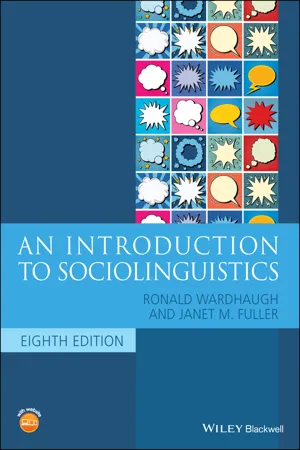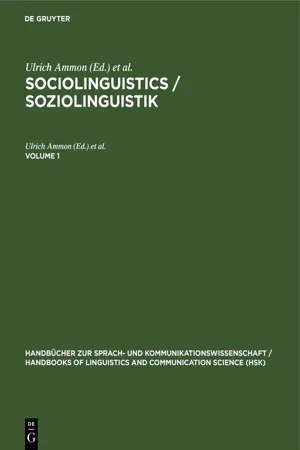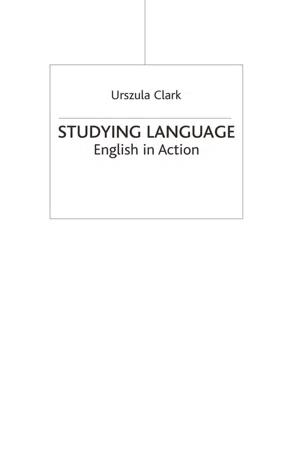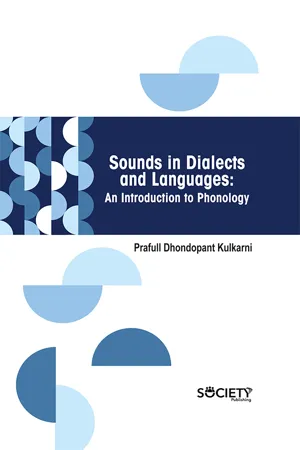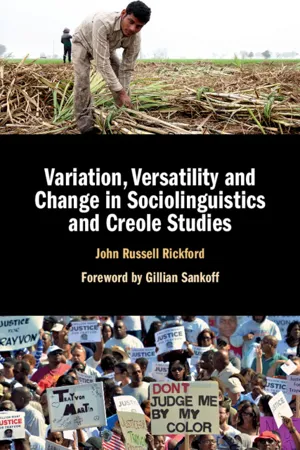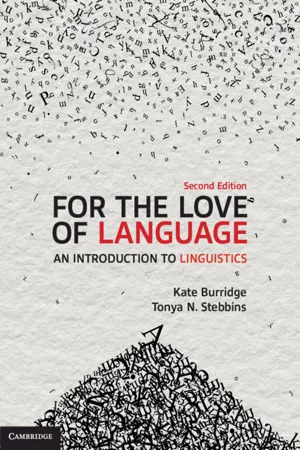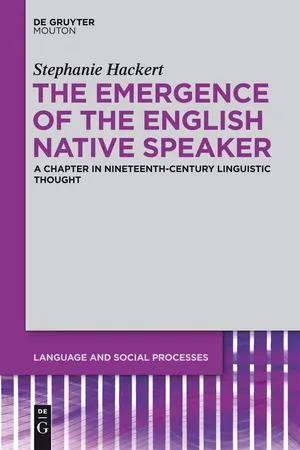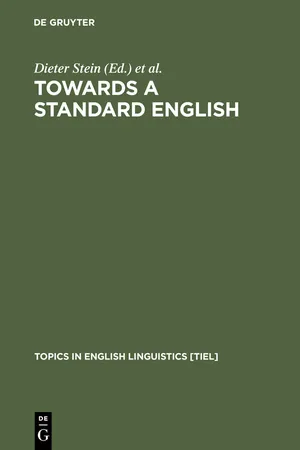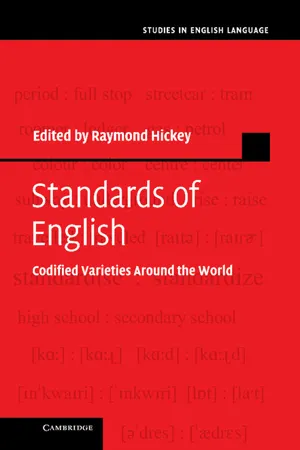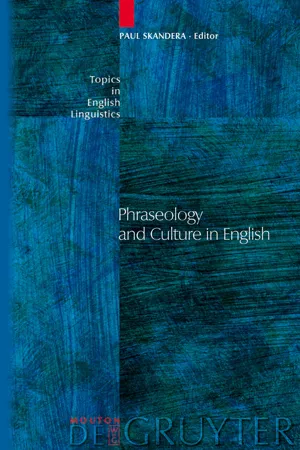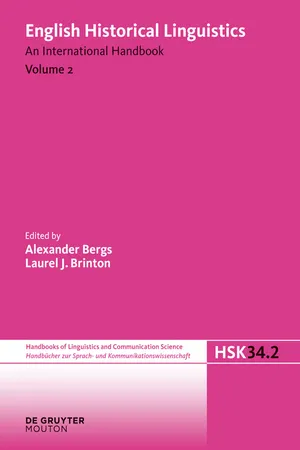Languages & Linguistics
Variety vs Standard English
Variety vs Standard English refers to the distinction between different forms of English used in various social, regional, and cultural contexts. Variety English encompasses the diverse dialects and vernaculars spoken by different communities, while Standard English represents the formal, widely accepted version of the language used in education, media, and official communication. This distinction highlights the dynamic nature of language and the importance of understanding and respecting linguistic diversity.
Written by Perlego with AI-assistance
Related key terms
1 of 5
12 Key excerpts on "Variety vs Standard English"
- eBook - PDF
- Ronald Wardhaugh, Janet M. Fuller(Authors)
- 2021(Publication Date)
- Wiley-Blackwell(Publisher)
Also, such prescriptivist views are inherently classist and discriminatory against anyone who is not a member of the privileged class; we will develop our ideas about this below in our discussion of the standard language ideology. Languages, Dialects, and Varieties 33 Standard language? It is not at all easy for us to define a standardized language because of a failure to agree about the norm or norms that should apply. For example, Trudgill (1995, 5–6) defines Standard English as the variety which is: ● Usually used in print ● Normally taught in schools ● Learned by non-native speakers ● Spoken by educated people ● Used in news broadcasts Note that this definition revolves around how it is used, not the particular features of the language, as Standard English is constantly changing and developing. While Trudgill writes specifically about Standard English, this is true for all languages. While some languages do have institutions which dictate what is considered standard, this will change over time to recognize new norms. Trudgill also points out that the standard is not the same as formal language, as the standard can also be used colloquially. What variety is considered the standard is something that is specific to the language; while it is generally a variety associated with a high-status group, the history behind the development of a particular variety as the normative standard is quite culturally specific. For pluricentric languages such as English, there are different paths to the development of the different regional standards (see also Dollinger 2019 for a discussion about this for German). The standardized variety of British English is based on the dialect of English that developed after the Norman Conquest resulted in the permanent removal of the Court from Winchester to London. This dialect became the one preferred by the educated, and it was developed and promoted as a model, or norm, for wider and wider segments of society. - eBook - PDF
- Ulrich Ammon, Norbert Dittmar, Klaus J. Mattheier, Peter Trudgill, Ulrich Ammon, Norbert Dittmar, Klaus J. Mattheier, Peter Trudgill(Authors)
- 2020(Publication Date)
- De Gruyter Mouton(Publisher)
In such a situation one must decide on specific terms and explain the concepts they denote at least to an extent whereby the worst errors can be avoided. We have decided on the two terminological pairs mentioned in the title: language — variety and standard variety — dialect. The relations between the denoted concepts are by no means analogous. Languages are sets of varieties and thus varie-ties are elements of languages; standard varie-ties and dialects ( = dialectal varieties) on the other hand are various types of such elements (varieties). So a language can contain dialects and one or more standard varieties (whereby a variety is never a dialect and a standard variety simultaneously) as well as other types of varieties. According to this macrosocio-linguistic view, which we will take from now on, entire linguistic systems (not elements of such systems or linguistic items) are always related to each other. One has to be aware of the fact that there are other meanings of the four terms ( lan-guagevariety, standard variety, dialect) bes-ides those on which we decided; ours are possibly not even the most common. In the linguistic context language is in the main understood to be 'langue/competence' as opposed to 'parole/performance'. This con-ceptual pair is on a completely different level from the focus of interest here: 'set of variet-ies' — 'single variety'. In addition, this differ-entiation, common in linguistics, can be ap-plied less problematically to single varieties than to languages in the sense of sets of varieties. Only single varieties can be realized as utterances (parole), sets of varieties cannot (except in the extreme case of the singleton); and similarly there are usually only true na-tive speakers and real competence in the case of single varieties (or several single varieties), but hardly ever in the case of entire languages in the sense of sets of varieties. (Ideal speakers may certainly be constructed for any set of varieties whatsoever). - eBook - PDF
Studying Language
English in Action
- Urszula Clark(Author)
- 2017(Publication Date)
- Red Globe Press(Publisher)
By con-trast speakers of standard English with a Received Pronunciation accent (see Section 1.3.1) are often portrayed as more intelligent than speakers of other dialects as well as morally and socially superior. Linguists prefer to use the term ‘variety’ when describing variations in lan-guage as this has none of the negative connotations associated with the terms dialect and accent, and fits in with the idea of descriptive linguistics; that is, basing descriptions of language upon actual use. It can also be applied across a wider range of language features. For example we can talk of linguistic vari-ation, historical variation, social variation, geographic variation, stylistic vari-ation and so on. Language operates across two dimensions simultaneously: the horizontal dimension of space, called the ‘diachronic’ axis, and the vertical dimension of time, called the ‘synchronic axis’. In addition there is a social dimension, which takes account of variations between social classes and cuts across both. The reason why there is so much geographic variation in language in England and so little in the United States is historical, as is the prejudice commonly held against linguistic variations. Consequently in order to comprehend vari-ations in English and the attitudes towards them it is necessary to consider the social history of English. ❙ 1.3 Standards of English 1.3.1 What is standard English? The term standard English (SE) is the one most commonly applied to the lan-guage ‘English’. It is the variety of English used in public life, for example in education, the law, medicine and government. Nowadays it has no geograph-ical boundary and is used throughout the United Kingdom and other English-speaking countries. In England it has an associated accent, known as Received Pronunciation, or RP for short. Because of their origins and history, SE and RP STUDYING LANGUAGE 8 - Prafull Dhondopant Kulkarni(Author)
- 2023(Publication Date)
- Society Publishing(Publisher)
Such flighty, individual contrasts are of little interest to language specialists, in any case (aside from, maybe, those worried about scientific voice ID). Linguists, especially sociolinguists, are keen on examples of the variety, and designs that uncover the connection between phonetic and social frameworks. Sociolinguists might be keen on the variety that is corresponded with the place (tongue), circumstance (register), or social connection and recognizable proof, including class, race, orientation, sexuality, age, and enrollment in various networks. 8.1. INTRODUCTION Language variety is a noticed peculiarity found in each language in this world. Variety is a long way from being a deformity of a language; the facts confirm that personal language is represented framework in which a colossal measure of imagination which is one of the significant qualities of language is conceivable. Variety is an unbiased activity, and etymologists couldn’t demonstrate that non-standard language (lingo) is less enough through correspondence than what is called standard language, so variety doesn’t make the language less in quality or rank, however, the issue is in the discourse local area perspective’s to the speakers or talkers of these tongues, discourse local area is the capacity to give a social status to the various types of language, and the question of disparaging and lifting a few speakers relies straightforwardly upon the foundation of the speaker and the capacities which depends on the choosing and articulating of certain words. Each language has its assortments or lingos, when a specific assortment of a language is utilized by the clients then it is called the tongue, vernaculars still up in the air by speaker’s topographical foundation, O Grady et al. Characterize tongue as “A provincial or social assortment of a language portrayed by its own phonological, grammatical, and lexical properties.” Assuming we accept English, for instance.- John Russell Rickford(Author)
- 2019(Publication Date)
- Cambridge University Press(Publisher)
7 Variation and the Versatility Approach to Language Arts in Schools and Societies Angela E. Rickford and John Russell Rickford 7.1 Introduction A fundamental principle of variation theory, from its inception more than fifty years ago, is that linguistic variation is the norm rather than the exception in human language use. 1 Indeed, it was the weakness of the standard tools for analyzing such variation in linguistics (free variation and categorical condi- tioning), pitted against the strength and ubiquity of variation in language, that led to the development of modern sociolinguistics, with its concepts of inherent variability, quantitative and variable-rule analysis, attentiveness to the social and stylistic dimensions of language use and so on. 2 In American and other schools around the world, however, English and language arts teachers often seek to limit the linguistic variation of their students, deeming non-standard or vernacular varieties unacceptable for class- room (sometimes even playground) use, and eschewing literary materials or pedagogical approaches that refer to or use such varieties. The motivation for this is understandable: Teachers and parents alike usually want to ensure that students acquire the standard variety associated with academic success and upward socioeconomic mobility. But the approach is ironic since some of the most successful authors and poets – Chinua Achebe, Robert Burns, James Joyce, Paule Marshall, Toni Morrison, V. S. Naipaul, Raja Rao and Alice Walker, to name just some of those who write in English – draw creatively both on their standard and vernacular varieties. Moreover, the experimental evidence we have on this point (see below) suggests that outlawing or ignoring the vernacular is LESS effective at helping students acquire the standard variety than recognizing it, using it 3 and studying its similarities to and differences from the standard via Contrastive Analysis (CA) and other methods.- eBook - PDF
For the Love of Language
An Introduction to Linguistics
- Kate Burridge, Tonya N. Stebbins(Authors)
- 2019(Publication Date)
- Cambridge University Press(Publisher)
Subtle nuances of meaning can be captured very neatly by these compound modal constructions – and with time you’ll might could get used to it! Dialects then are all the regionally, socially and also temporally defined varieties that fall within a larger named grouping like ‘the English language’, ‘the Russian language’, ‘the Japanese language’ and so on. While pronunciation differences alone don’t make a variety a distinct dialect, if speakers have a different accent, they will likely also show differences in their grammar. Although we have made a sharp demarcation here between accent and dialect, differences in accent are usually accompanied by distinct lexical and grammatical features. STANDARDISED LANGUAGE Variety might be a fact of linguistic life, but there are homogenising forces at work seeking to stamp it out. In Chapter 15, we look more closely at what happens to languages when they are standardised, but really it isn’t too different from normalising processes in other domains. You might compare the story of what happened to bananas when the European Union brought in regulations for their production. While crooked bananas weren’t actually banned (this is a ‘euromyth’), Regulation (EC) 2257/94 did specify that the fruit must be ‘free from malformation or abnormal curvature’. Standardisation (international and national) promotes uniformity and establishes norms and requirements, whether it be for bananas, screw-thread sizes or languages. In the case of a language, standardisation legitimises a single fixed and approved vari- ety. So, dictionaries and grammar books record, regulate, tidy up and iron out variation. With the ground rules on usage laid down, there is no longer any official room for options. 305 CHAPTER 10: Variation and identity Speakers cannot vacillate between forms such as I done it and I did it, or lie and lay – one choice only carries the stamp of approval. - eBook - PDF
The Emergence of the English Native Speaker
A Chapter in Nineteenth-Century Linguistic Thought
- Stephanie Hackert(Author)
- 2012(Publication Date)
- De Gruyter Mouton(Publisher)
[…] It is perhaps said, “You admit a considerable amount of differentiation in your so-called Standard English, and yet you adhere to the conception of a Standard. How is this logical?” The reply to this objection is, that the distinctions between the different forms of Standard English are very slight, almost imperceptible, indeed, to any but the most alert and practised observer, and that they shrink to a negligible quantity compared with the differences between out-and-out “Vulgarism” on the one hand, or provincial – that is, regional – dialects on the other. In Standard English, as with all other forms of speech, a certain degree of divergence is possible, without such divergence being felt as constituting a different dialect. Of a dozen speakers of Standard English, each may possess slight differences of utterance, or phra-seology, and yet none feel that the speech of any of the others, even where it differs from his own, verges towards Vulgarism or “Dialect” in the special sense. (Wyld 1969 [1906]: 354–355) To sum up, with regard to the spoken form of standard English, variation was not only recognized but at the same time officially endorsed, as it satisfied the theo-retical demand that language be living and changing rather than artificial and 132 The question of standard spoken English and the dialects dead, an idea to be discussed in more detail below. Thus, unlike the written, liter-ary standard, the spoken standard could not be described as uniform linguisti-cally; it therefore had to be described by means to the group of speakers to which it “belonged,” i.e., the class of (public-school) educated Britons. These speakers and their linguistic behavior were then described by means of epithets such as “good” and “best,” which obviously introduced a strongly evaluative dimension into the debate about spoken standard English. - eBook - PDF
Towards a Standard English
1600 - 1800
- Dieter Stein, Ingrid Tieken-Boon van Ostade, Dieter Stein, Ingrid Tieken-Boon van Ostade(Authors)
- 2012(Publication Date)
- De Gruyter Mouton(Publisher)
1. Notions of standard A major theoretical issue lies in the fact that it is not the case that all of the in-cipient or, to various degrees, embryonic forms of more widely used prestige 2 Dieter Stein varieties in the history of English could, by a more strict definition, be called standard languages. There seem to be three uses of the term standardiza-tion. There is an extended use which would apply to all manner of varieties, the notion of standardization with standard as the resulting variety. To this type of variety James Milroy (this volume) assigns the term supra-local language norms. These constitute localized or regional norm standards. Such varieties are instances of language convergence in various degrees and certainly carry prestige, which is largely a function of their use in various combinations of the following situations, such as are listed by Görlach (1988: 133-134): a) as a written language b) as a literary language c) as a religious language d) as a language of education and science e) as a language of the law courts, parliament and the court etc. f) as a lingua franca g) as a national language h) as a language of the mass media (newspaper, radio, television etc.). This first, wide, notion of the term standard seems to be inherent in the majority of work on at least the history of English (Görlach 1988, Trahern 1989). A second, narrow or restricted, definition of standardization was devel-oped in language planning research in countries with no nationally accepted varieties and with the problem of having a language in addition to a range of dialects. Haugen (1966) describes the following constitutive processes in creating a standard language: • selection • codification • elaboration • acceptance. Garvin (1964), based on Garvin and Mathiot (1960), gives the following defining features for a standard language: 1. the intrinsic properties of a standard language; 2. the functions of a standard language within the culture of a speech commu-nity; 3. - eBook - PDF
Standards of English
Codified Varieties around the World
- Raymond Hickey(Author)
- 2012(Publication Date)
- Cambridge University Press(Publisher)
It is also true, regarding what is possible in the language, that English speakers from anywhere in the anglophone world would find it hard to believe how many different constructions and variants are current somewhere else in the world, if they were to inspect a reference like Kortmann and Schneider (2004). English is a much more various language than anybody, linguists and non-linguists alike, will give it credit. The idea of Standard American English 149 kinds of transactions (text types) – this for every feature in the stream of features that compose speech, in real time as the transaction is taking place. Asynchronous modes like writing allow a little more time for reflection but require the same decisions. Some of us are more talented at managing these decisions, but all of us are faced with the problem, and mostly succeed, every time we try to use our language. 7.3 Standard American English and other varieties After the foregoing discussion, it is now clear why an institutional language construct like Standard American English is not the same sort of thing as a natural language variety. The claim that there is a ‘standard’ in the sense of a ‘default’ variant for any linguistic feature is not compatible with the com- plex system of language in use, whether in pronunciation, grammar or lexi- con. At best, codification by observation of what people say and write might consist of recording the ‘norms’ of a variety, the most common variants of some features, and this is what descriptive linguists attempt to do. But that is not what actually happens in anyone’s description of a standard, including descriptions by linguists, who have not given sufficient credit to the omni- present frequency distributions of variants (see, however, Biber, Johansson, Leech, Conrad and Finegan 1999, which does offer frequency information for many features of grammar). - eBook - PDF
- Paul Skandera(Author)
- 2008(Publication Date)
- De Gruyter Mouton(Publisher)
As M.A.K. Halliday has put it in a recent essay on English as a “written language, standard language, global language,” the most appropriate ap-proach to studying lexical variability in world English is to describe: 1. not just new words, but new word-making principles; 2. not just new words, but new word clusters (lexical sets); 3. not just new words, but new meanings; 4. not just new words, but new registers (functional varieties). (2003: 408) This shift of emphasis from isolated words as static “products” in a decon-textualised lexicon to the process of deploying (and combining) words in context-embedded discourses will lead to a richer linguistic description because it focusses on: […] ways of opening up, of expanding the semiotic potential that inheres in every language: opening up the creation of new terms; opening up the di-mensions along which these terms are organized, opening up the meaning-making resources of the lexicogrammar; opening up the modes of creating and transmitting knowledge, maintaining and strengthening authority. (2003: 409) Varieties of English around the world 439 Explaining variability in written English in a contextually sensitive us-age- and performance-based framework has several advantages. First, it helps us get around the obvious problem that writers do not consistently use the features supposedly “typical” or “characteristic” of their variety but also use alternative forms. This is true even for British and American texts, that is the two varieties with the longest history of standardisation behind them, 2 and it is glaringly obvious in the case of the more recent emerging standards of, say, India and the Caribbean, where the lexico-grammatical regionalisms almost always co-exist with British or Ameri-can expressions (and are commonly used in a minority of instances). - eBook - PDF
- Ladislav Zgusta, Vera Cerny(Authors)
- 2010(Publication Date)
- De Gruyter Mouton(Publisher)
15 The actual situations differ vastly one from the other, in different languages not only in the degrees of difference between the levels of a language, but also in the strength of local dialects and the number of dialectisms (which frequently differ from speaker to speaker and from author to author, is the standard national language is not well stabilized) in the standard national language. There are also other possible situations. Sometimes it is necessary to accept more levels of language than described here, sometimes the local dialects develop a written form of 13 If we decide to use another terminology in which the standard national language would be one of the dialects (cf. footnote 11), this sentence would have to be re-worded, but its meaning would remain unimpaired. 14 But it is not a true dialectism if an author tries to give local flavour to history by using dialectical words when describing the province; or even when he uses them in direct speeches of local persons in novels, etc. 15 The preceding classification is highly dependent on Gleason, Introduction 405. 172 VARIATION IST LANGUAGE their own, and sometimes there is not one single form of the standard national language but more varities of it, owing to geographical, cultural or other reasons. 16 STYLES AND RESTRICTED LANGUAGES etc.; DIGLOSSIA 4.3 These variations are in language of very different types. Practically omni-present is the variation of style. When communicating in the standard national language, and also when speaking any dialect, a speaker has the possibility to choose among different levels of style, from the stiftest to the most careless ones. But as the use of dialects is functionally restricted, dialectal texts (spoken or written) in our times usually show a smaller degree of stylistic variation. The standard national language is functionally much more diversi-fied, and the urban population is much more stratified that the rural one. - eBook - PDF
- Alexander Bergs, Laurel J. Brinton, Alexander Bergs, Laurel J. Brinton(Authors)
- 2012(Publication Date)
- De Gruyter Mouton(Publisher)
After all, if a phenomenon that exists cannot be described in aca-demic terms, the problem needs to be solved at the level of the academic discipline. The phenomenon cannot be changed to fit the existing conceptualization. It cannot be abolished either. At best its existence can be ignored or deplored, which some lin-guists have been trying to do since 1984. Hence the rare occurrence of the term ‘EE’ in studies on EE-related topics (see Sections 2, 3, 4 and 5). However, the term keeps coming back, which speaks for the existence of the phenomenon. Wells, for example, grudgingly concedes: Many of our native-speaker undergraduates use a variety of English that I suppose we have to call Estuary English, following Rosewarne 1984, 1994, Coggle 1993, and many recent reports on press and television […] This means that their accent is located some-where in the continuum between RP and broad Cockney […] As with the equally unsatisfactory term Received Pronunciation , we are forced to go along. (Wells 1995: 261) Instead of feeling forced to go along with this unsatisfactory term, I propose to recon-sider the sociolinguistic concepts applied to EE. It is not EE but the concept of “variety” and the theory of variation behind it that constitute the problem. The concept of “variety” is a system-based ideal. In requiring varieties to be suffi-ciently internally homogeneous and externally distinct, theorists of language variation ideally aim at categorical variation or at least at a categorical co-occurrence of less categorical variants. Although they concede that in linguistic reality such categorical variation is hard to encounter (e.g. Berruto 1987: 265; Wunderli 1992: 182), they still require as much internal homogeneity as possible as “Verdichtungspunkte in einem Kontinuum” [‘centers of gravity on the continuum’] in Berruto’s (1987: 265) terminology, and as “centers ou points de gravitation” [‘centers or points of gravity’] in Wunderli’s (1992: 182) terms.
Index pages curate the most relevant extracts from our library of academic textbooks. They’ve been created using an in-house natural language model (NLM), each adding context and meaning to key research topics.
